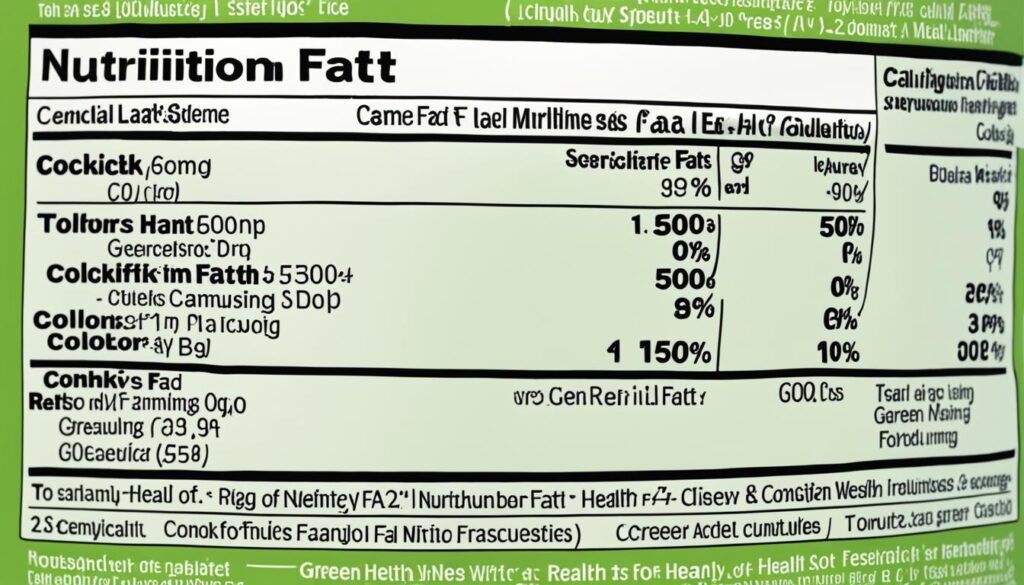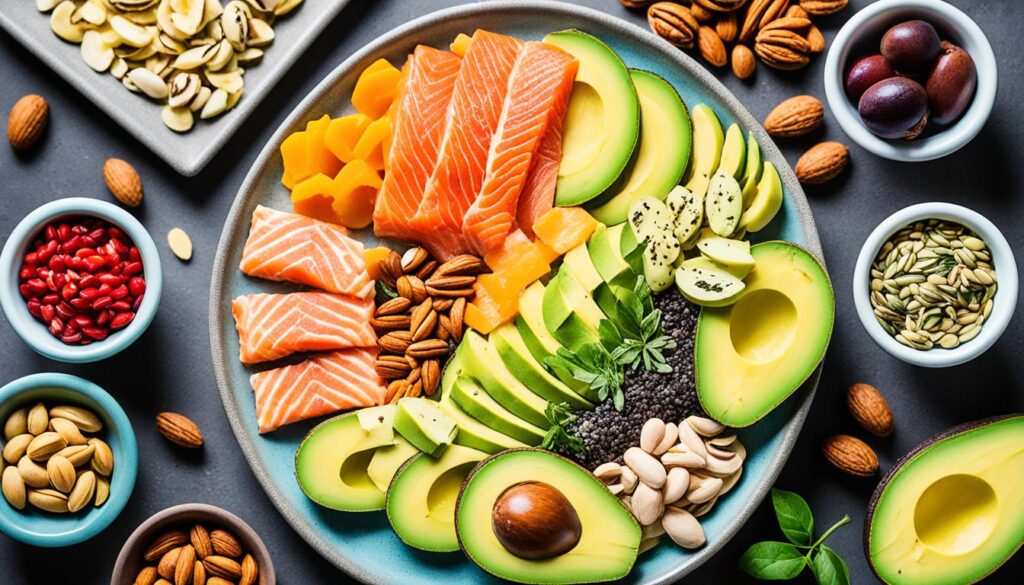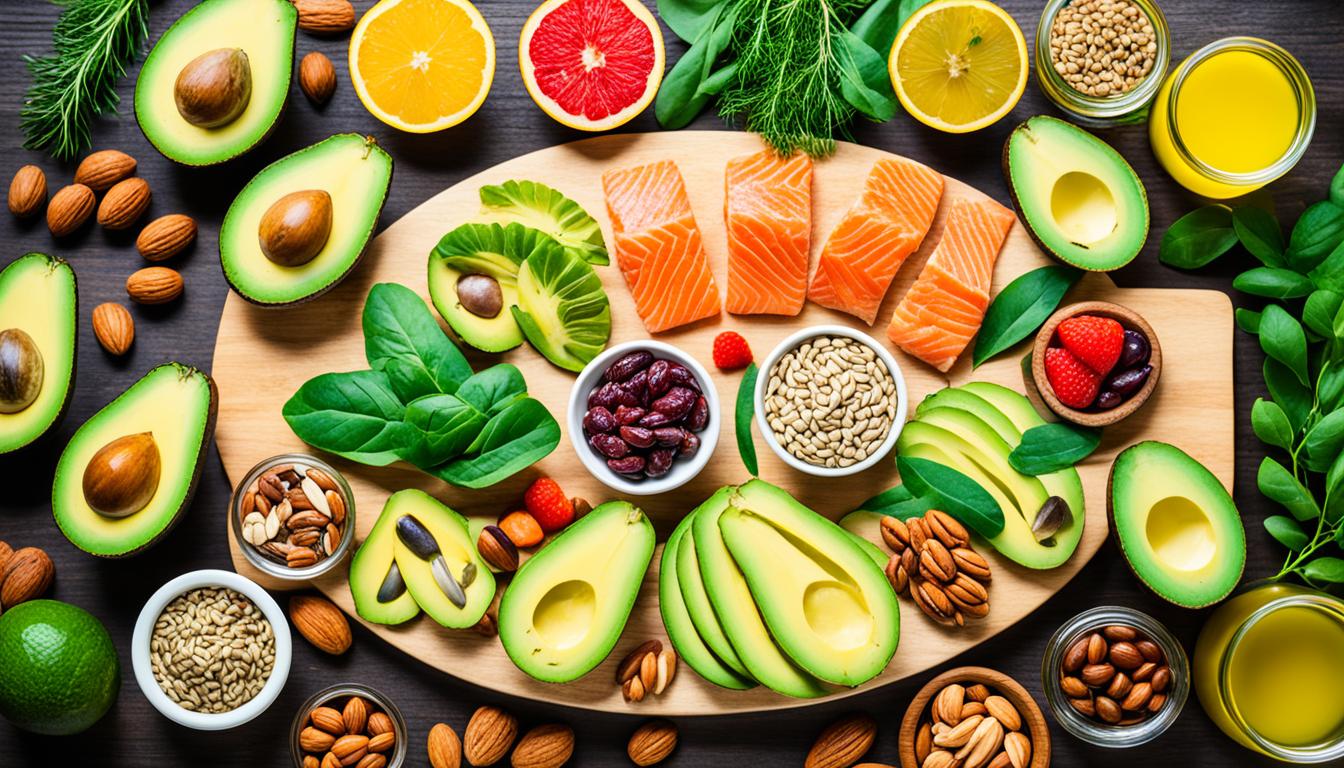In a world where fat has been often demonized, it may come as a surprise that certain types of fats are actually essential for our overall health and well-being. But what makes a fat “healthy,” and how can we ensure we’re getting the right balance in our diets? Are all fats created equal, or are some truly better for us than others?
Fats are a crucial macronutrient, providing our bodies with energy, supporting the absorption of essential vitamins, and playing a vital role in various bodily functions.However, consuming too much of the wrong types of fats, such as saturated and trans fats, can have negative consequences on our health, potentially leading to higher cholesterol levels and an increased risk of heart disease1.
In this article, we’ll dive deep into the world of healthy fats, exploring the different types, their benefits, and how to incorporate them into a balanced, nutritious diet. By understanding the role of fats in our bodies and making informed choices, we can unlock a path to improved overall wellness and optimal body function.
Key Takeaways
- Fats are an essential part of a healthy, balanced diet, providing energy, supporting vitamin absorption, and aiding various bodily functions.
- Consuming too much unhealthy fat, such as saturated and trans fats, can raise cholesterol levels and increase the risk of heart disease.
- Understanding the different types of fats, including monounsaturated and polyunsaturated fats, is crucial for making informed dietary choices.
- Incorporating more healthy fats into the diet, while limiting unhealthy fats, can contribute to overall wellness and optimal body function.
- Balancing calorie intake from all food sources, including fats, with physical activity is important for maintaining a healthy weight and lifestyle.
The Importance of Healthy Fats
While it’s widely known that fats should be limited, the truth is that a small amount of healthy fats is essential for our bodies2. These essential fatty acids, which our bodies cannot produce on their own, play a crucial role in maintaining overall health and well-being.
Why We Need Some Fat
Fats are not just a source of energy for the body’s cells, but they also help us absorb important fat-soluble vitamins like A, D, E, and K2. Moreover, healthy fats have been shown to lower the risk of heart disease and improve blood cholesterol levels2. Incorporating the right types of fats into our diets can provide significant benefits for our overall health.
Fat’s Role in Nutrient Absorption
In addition to their energy-providing capabilities, fats play a crucial role in the absorption of essential vitamins2. Without the presence of healthy fats, our bodies would struggle to effectively utilize these fat-soluble vitamins, which are crucial for maintaining strong bones, a healthy immune system, and proper organ function.
While guidelines recommend limiting saturated and trans fats, getting the right amount of healthy fats is crucial for overall wellness2. Olive, safflower, corn, sesame, canola, walnut, soybean oils, as well as walnuts, flax seeds, chia seeds, soybeans, avocados, olives, and fatty fish are all excellent sources of healthy fats2.
“Cooking with vegetable oils, limiting saturated fats, avoiding trans fats, and including at least one good source of omega-3 fats daily are recommended dietary practices.”2
Understanding Different Types of Fats
Navigating the complex world of dietary fats can be a challenging task, but understanding the different types is crucial for maintaining a healthy lifestyle. Fats are not created equal, and each category has its own unique properties and effects on the body.
Saturated Fats: Sources and Effects
Saturated fats, primarily found in animal products and some plant oils, have long been a topic of concern when it comes to heart health. According to the UK government, men should consume less than 30g of saturated fat per day, while women should limit their intake to less than 20g3. Excess consumption of saturated fats can raise “bad” LDL cholesterol levels and increase the risk of heart disease3.
Trans Fats: The Unhealthy Option
Trans fats, also known as partially hydrogenated oils, are considered the most harmful type of fat. The UK government advises limiting trans fat intake to less than 5g per day for both men and women3. Children should also consume less trans fat and saturated fat compared to adults3. Trans fats have been shown to raise “bad” LDL cholesterol levels and lower “good” HDL cholesterol, contributing to an increased risk of heart disease4. In fact, the U.S. has nearly eliminated artificial trans fats from the food supply due to these health concerns4.
Identifying and minimizing the intake of saturated and trans fats is crucial for maintaining a healthy heart and overall well-being. By making informed choices and prioritizing healthier fat options, individuals can take an active role in their cardiovascular health.
| Fat Type | Recommended Daily Intake | Health Effects |
|---|---|---|
| Saturated Fats | Men: Less than 30g3 Women: Less than 20g3 |
Can raise “bad” LDL cholesterol levels and increase the risk of heart disease3 |
| Trans Fats | Less than 5g for both men and women3 | Raise “bad” LDL cholesterol and lower “good” HDL cholesterol, contributing to an increased risk of heart disease4 |
“Excess consumption of saturated and trans fats can have detrimental effects on heart health, making it crucial to be mindful of the types of fats we consume.”
By understanding the different types of fats and their respective impacts on our health, we can make more informed choices and prioritize the inclusion of healthier fats in our diets. This knowledge is a vital step towards maintaining a balanced and nutritious lifestyle345.
Monounsaturated Fats: The Heart-Healthy Choice
Monounsaturated fats, found in foods like olive oil, avocados, and nuts, are considered a heart-healthy choice. These fats can help maintain “good” HDL cholesterol levels while reducing “bad” LDL cholesterol6. Incorporating more monounsaturated fats into the diet can lower the risk of heart disease and stroke6. Diets high in omega-3 fatty acids may also lower levels of triglycerides in the blood6.
The Dietary Guidelines for Americans recommend that less than 10% of calories a day should be from saturated fats6. Eating plant foods high in monounsaturated fats, particularly extra virgin olive oil and tree nuts, may benefit heart health and blood sugar regulation6. Monounsaturated fats can help lower LDL (bad) cholesterol levels, reducing the risk of heart disease and stroke7.
Food labels provide fat content information, helping individuals monitor their fat intake7. Different types of fats found in packaged foods include saturated fats, trans fats, and unsaturated fats (monounsaturated and polyunsaturated)7. To receive health benefits, it is recommended to replace unhealthy fats with healthier monounsaturated fats in one’s diet7.
“Monounsaturated fats from plants may lower bad cholesterol and raise good cholesterol.”6
| Type of Fat | Recommended Intake | Sources |
|---|---|---|
| Monounsaturated Fats | 25% to 30% of daily calories | Olive oil, avocados, nuts, and seeds |
| Polyunsaturated Fats | Included in the 25% to 30% of daily calories | Fatty fish, walnuts, flaxseeds, and sunflower seeds |
| Saturated Fats | Less than 10% of daily calories | Meat, dairy, and tropical oils |
| Trans Fats | As little as possible | Partially hydrogenated oils in processed foods |
In summary, monounsaturated fats are a heart-healthy choice that can help maintain good cholesterol levels and reduce the risk of heart disease and stroke67. By incorporating more monounsaturated fats into the diet and replacing unhealthy fats, individuals can improve their overall cardiovascular health7.
Polyunsaturated Fats: Essential for Good Health
Polyunsaturated fats, including omega-3 and omega-6 fatty acids, play a vital role in maintaining our overall health. These essential fatty acids cannot be produced by the body and must come from the diet8. They offer a range of benefits, from lowering LDL (bad) cholesterol and reducing the risk of heart disease to helping control blood sugar and blood pressure.
Omega-3 and Omega-6 Fatty Acids
Omega-3 fatty acids, found in oily fish and some plant sources, are crucial for brain function, cell growth, and reducing inflammation9. On the other hand, omega-6 fatty acids, present in vegetable oils, may also help control blood sugar, lower blood pressure, and decrease the risk of diabetes8.
The key is to maintain a balanced intake of these polyunsaturated fats. The 2020-2025 Dietary Guidelines for Americans recommend getting no more than 10% of daily calories from saturated fat and keeping total fat consumption to 25-30% of daily calories8. Eliminating saturated fats is twice as effective in lowering blood cholesterol levels as increasing polyunsaturated fats8.
| Polyunsaturated Fat Source | Omega-3 Content | Omega-6 Content |
|---|---|---|
| Salmon (3 oz/85g) | 1.8 g | 0.2 g |
| Safflower Oil | 0 g | 74.6 g |
| Flaxseed Oil | 7.3 g | 22.8 g |
Incorporating polyunsaturated fats into your diet can provide numerous health benefits8. However, it’s important to be mindful of the sources and to balance the intake of omega-3 and omega-6 fatty acids to maintain overall well-being9.
“Polyunsaturated fats are an essential part of a healthy diet, providing numerous benefits for heart, brain, and overall health. Balancing their intake is key to reaping the full rewards.”
Balancing Fat Intake for Optimal Nutrition
Achieving optimal nutrition requires a careful balance of different types of fats. Current dietary guidelines recommend that 20-35% of daily calories should come from fat, with a focus on replacing saturated and trans fats with healthier unsaturated fats10. This balance can help support heart health, nutrient absorption, and overall body function.
To promote optimal health, it’s essential to limit saturated fats to less than 10% of total energy intake and trans fats to less than 1%10. Additionally, free sugars should be kept below 10% of total energy intake, with a further reduction to less than 5% for enhanced health benefits10. Consuming at least 400g of fruits and vegetables daily is also recommended to help mitigate the risk of noncommunicable diseases10.
When it comes to fat intake, the focus should be on increasing the consumption of unsaturated fats, such as monounsaturated and polyunsaturated fats11. Monounsaturated fats can lower the risk of heart disease and stroke by reducing LDL cholesterol levels, while polyunsaturated fats can help regulate heart rhythm, slow artery plaque buildup, and lower blood pressure11.
By following a balanced diet that emphasizes healthy fats, individuals can optimize their nutrient intake and support overall well-being11. It’s important to consult with healthcare professionals or registered dietitians to develop a personalized plan that aligns with individual needs and preferences.
Reading Food Labels for healthy fat
Decoding the nutrition information on food labels can be a valuable tool in making informed decisions about the types and amounts of fats in your diet. By understanding the labeling, consumers can identify healthier fat choices and steer clear of potentially harmful varieties12.
The nutrition facts panel provides details on the total fat content, as well as the breakdown of saturated, trans, and other fats. As a general guideline, foods with more than 17.5g of fat per 100g are considered high in fat, while those with 3g or less per 100g are low in fat12. When it comes to saturated fat, the healthiest options have 1.5g or less per 100g, and high-saturated fat foods contain more than 5g per 100g12.
Savvy shoppers should also pay attention to the trans fat content, as this type of fat has been linked to increased cholesterol levels and elevated risk of heart disease. Ideally, the nutrition label should show 0g of trans fat per serving12.
Many food labels also feature color-coded nutrient information, using red for high, amber for medium, and green for low amounts of fat, saturated fat, sugars, and salt. This visual cue can quickly guide consumers toward healthier choices12.
| Nutrient | Low | High |
|---|---|---|
| Total Fat | 3g or less per 100g | More than 17.5g per 100g |
| Saturated Fat | 1.5g or less per 100g | More than 5g per 100g |
| Sugars | 5g or less per 100g | More than 22.5g per 100g |
| Salt (Sodium) | 0.3g or less per 100g | More than 1.5g per 100g |
Understanding how to interpret nutrition labels can empower consumers to make healthier fat-related choices and ultimately support their overall well-being12.

Cooking with healthy fat
When it comes to cooking, the type of fat you choose can make a significant difference in the nutritional value of your meals. To promote a balanced and healthy diet, it’s important to opt for liquid, plant-based oils that are high in heart-healthy monounsaturated and polyunsaturated fats13. These oils, such as olive, avocado, and nut oils, have lower melting points and are typically liquid at room temperature, making them ideal for various cooking methods13.
On the other hand, it’s best to limit the use of solid fats like butter, lard, and coconut oil, which are higher in saturated fat14. Saturated fats do not have double bonds and are solid at room temperature, while unsaturated fats have at least one double bond and are typically liquid13. Additionally, it’s crucial to avoid trans fats, which are created through a chemical process and can have detrimental health effects13.
When selecting oils for cooking, consider the smoke point, which determines the oil’s ability to handle heat without burning or producing harmful compounds13. Oils with a high smoke point, such as avocado oil (approximately 520°F or 271°C) and coconut oil, are ideal for high-heat cooking methods like sautéing and stir-frying15. On the other hand, oils with a lower smoke point, such as olive oil (approximately 350°F or 176°C), are better suited for low-heat cooking or cold dishes to avoid oxidation15.
By incorporating healthy fats into your meal preparation, you can contribute to a more balanced and nutritious diet13. Embrace the versatility of plant-based oils, and experiment with different options to find the ones that best suit your cooking needs and personal preferences13. Remember, a little bit of healthy fat can go a long way in enhancing the flavor and nutritional value of your homemade meals.
- Olive oil:1514 A monounsaturated fat with a medium-high smoke point, suitable for low to medium-heat cooking.
- Avocado oil:1315 A monounsaturated fat with a high smoke point, perfect for high-heat cooking methods like sautéing and grilling.
- Sesame oil:15 A flavorful oil with a medium-high smoke point, great for stir-fries and sauces.
- Walnut oil:13 A polyunsaturated fat with a low smoke point, better suited for baking and cold dishes.
- Ghee:13 A form of clarified butter that can be used for both low and high-heat cooking, with potential health benefits.
By carefully selecting and incorporating healthy fats into your cooking, you can create delicious and nutritious meals that support your overall well-being131514.
The Role of Fats in Disease Prevention
Consuming the right types of healthy fats can play a crucial role in preventing various chronic conditions. Replacing saturated and trans fats with unsaturated fats has been shown to lower the risk of heart disease, stroke, and type 2 diabetes16.
Healthy fats also have anti-inflammatory properties, which can help reduce the risk of conditions like arthritis, certain cancers, and Alzheimer’s disease16.
- Partial replacement of saturated fatty acids (SAFA) with unsaturated fatty acids is shown to improve the blood lipid and lipoprotein profile and reduce the risk of coronary heart disease (CHD)16.
- Very long-chain polyunsaturated n-3 or omega-3 fatty acids present in fish have multiple beneficial metabolic effects16.
- Regular intake of fatty fish is associated with lower risks of fatal CHD and stroke16.
- Food-based guidelines recommend limiting the consumption of animal fats high in SAFA16.
- Using vegetable oils high in monounsaturated (MUFA) and polyunsaturated fatty acids (PUFA) is recommended16.
Dietary fats play a vital role in preventing cardiovascular disease16. Additionally17, low-fat dietary patterns have been associated with a reduced risk of cardiovascular disease and mortality among women17.
The Women’s Health Initiative Dietary Modification Trial showed a link between adhering to a low-fat diet and reduced risk of treated diabetes mellitus in postmenopausal women17. Furthermore17, low-carbohydrate diets have been found to have effects on weight loss and cardiovascular risk factors compared to low-fat diets in randomized controlled trials17.
In conclusion, incorporating healthy fats into your diet can play a significant role in disease prevention, particularly in reducing the risk of heart health and chronic conditions1617.
Incorporating healthy fat into Your Diet
To reap the benefits of healthy fats, it’s essential to incorporate them into your daily diet. Focus on including a variety of nutrient-rich foods that are high in monounsaturated and polyunsaturated fats18. These unsaturated fats can help reduce the risk of heart disease and other chronic conditions, while supporting overall health18.
Healthy Fat-Rich Foods to Include
Start by adding the following nutrient-dense, healthy fat sources to your meals and snacks:
- Avocados19
- Nuts and seeds, such as almonds, walnuts, chia, and flax19
- Fatty fish like salmon, mackerel, sardines, and tuna19
- Olive oil, canola oil, and other plant-based liquid oils19
- Olives and olive tapenade19
- Peanut butter and other nut butters19
- Coconut and coconut oil20
- Whole grains like brown rice, wheat, and oatmeal20
Incorporating healthy fats into your diet can be as simple as swapping butter for olive oil when cooking, adding avocado to your sandwich, or snacking on a handful of nuts19. By making small, mindful choices, you can easily boost your intake of these essential nutrients19.

Remember, a balanced diet rich in healthy fats can provide numerous benefits, from supporting heart health to promoting nutrient absorption18. By making informed decisions and incorporating a variety of nutrient-dense, fat-rich foods, you can optimize your overall nutrition and well-being182019.
Myths and Misconceptions About Fats
Many misconceptions exist about dietary fats, including the belief that all fats are unhealthy and that low-fat or fat-free foods are always the healthiest choices21. However, the type of fat is more important than the total amount, and some fats, like those found in nuts, avocados, and olive oil, are essential for good health21. Understanding the nuances of fat intake is crucial for making informed dietary decisions.
One common myth is that all saturated fats are bad for you22. In reality, some saturated fats like those found in coconut oil can be part of a balanced diet when consumed in moderation22. Additionally, low-fat diets have been debunked, and an extreme reduction in fat intake can lead to nutritional deficiencies22.
Another misconception is that fat-free foods are always the healthier option21. In fact, fat-free foods may be high in sugar, refined carbohydrates, and calories, which can negatively impact weight loss efforts21. Dietary fat plays a crucial role in providing energy and assisting with the body’s functions, and consuming good fats in moderation can improve heart health and aid in the absorption of essential vitamins21.
- Monounsaturated and polyunsaturated fats are categorized as healthy fats21.
- Healthy fats, like omega-3 fatty acids, can reduce the risk of heart disease, memory loss, and joint pain21.
- Unhealthy fats, such as trans fats and saturated fats, can raise cholesterol levels21.
- Foods high in healthy fats include almonds, avocados, salmon, and walnuts21.
- Foods high in unhealthy fats include beef, cheese, and fast food21.
- Studies have shown that people with moderate- or high-fat diets can lose weight as effectively as those with low-fat diets21.
It’s important to understand that dietary fat is not the enemy22. Fats play a vital role in maintaining good health and should be incorporated as part of a balanced diet22.
By debunking these myths and misconceptions, we can make more informed choices about our fat intake and enjoy the benefits of a diet rich in healthy fats2122.
The Benefits of a Balanced Diet Rich in healthy fat
Incorporating a balance of healthy fats as part of an overall nutrient-dense diet can provide numerous benefits. These include supporting heart health, promoting brain function, reducing inflammation, aiding in nutrient absorption, and potentially reducing the risk of chronic diseases like heart disease, diabetes, and certain cancers23. Striking the right balance of fats, along with other essential nutrients, is key for optimal health and wellness.
Monounsaturated fats and polyunsaturated fats, known as the “good fats,” can help lower the risk of heart disease and stroke24. These healthy fats are found in sources like olive oil, avocados, nuts, seeds, fish oil, and tofu24. In contrast, artificial trans fats are considered the worst type of fat as they raise bad LDL cholesterol, lower good HDL levels, and increase inflammation24.
While saturated fats are not as harmful as trans fats, they can still raise bad LDL cholesterol and should be consumed in moderation24. Sources of saturated fats include red meat, whole-fat dairy products, butter, and tropical oils like coconut and palm oil24. On the other hand, omega-3 fatty acids found in fatty fish, algae, and some plant sources have numerous health benefits, including potentially preventing depression, heart disease, arthritis, and memory loss24.
Incorporating a balanced diet rich in healthy fats can have a significant impact on overall health and well-being23. By making informed choices and consulting with a registered dietitian, individuals can tailor their nutrition plan to achieve their fitness or health goals25.
Conclusion
In conclusion, dietary fats are a crucial component of a healthy, balanced nutrition for overall wellness. While it’s important to limit intake of saturated and trans fats, incorporating the right types of healthy fats, such as monounsaturated and polyunsaturated fats, can provide essential nutrients, support various bodily functions, and contribute to disease prevention26.
By understanding the different types of fats and their health implications, reading food labels, and making informed choices, individuals can optimize their dietary fat intake for better health. Studies have shown that dietary cholesterol was not associated with heart attack or stroke in a study of over 350,000 adults26, and consuming very long-chain fatty acids (VLCFAs) was associated with decreased risk of type 2 diabetes in a study of 16,000 European adults26.
Furthermore, research has indicated that saturated fat from certain sources, such as lard, may have different effects compared to the same saturated fat from tallow, and that avocados, despite containing saturated fat, were found to reduce levels of “bad” LDL cholesterol, unlike bacon26. By understanding these nuances and making informed choices, individuals can incorporate healthy fats into their balanced diet for optimal nutrition and overall well-being26.
FAQ
What are the main types of dietary fats?
The four main types of dietary fats are saturated, trans, monounsaturated, and polyunsaturated fats.
Why are healthy fats essential for the body?
Healthy fats provide energy, help absorb fat-soluble vitamins, and support various bodily functions. They are a source of essential fatty acids that the body cannot make itself.
How do saturated and trans fats affect health?
Saturated and trans fats can raise “bad” LDL cholesterol levels and increase the risk of heart disease. It’s important to limit the intake of these unhealthy fats.
What are the benefits of monounsaturated fats?
Monounsaturated fats, found in foods like olive oil, avocados, and nuts, can help maintain “good” HDL cholesterol levels while reducing “bad” LDL cholesterol, thereby lowering the risk of heart disease and stroke.
What are omega-3 and omega-6 fatty acids, and why are they important?
Omega-3 and omega-6 fatty acids are types of polyunsaturated fats that are essential for good health. They play important roles in brain function, heart health, and reducing inflammation, and must come from the diet.
How can I balance my intake of different types of fats?
Current guidelines recommend that 20-35% of daily calories should come from fat, with a focus on replacing saturated and trans fats with healthier unsaturated fats.
How can I identify healthy fats when reading food labels?
Look for foods low in saturated and trans fats and higher in monounsaturated and polyunsaturated fats. Reading nutrition labels can help guide you towards making more informed and nutritious fat-related decisions.
What are some healthy cooking oils to use?
Opt for liquid, plant-based oils like olive, avocado, or nut oils, which are high in healthy monounsaturated and polyunsaturated fats. Limit the use of solid fats like butter, lard, and coconut oil, which are higher in saturated fat.
How can healthy fats help prevent chronic diseases?
Replacing saturated and trans fats with unsaturated fats has been shown to lower the risk of heart disease, stroke, and type 2 diabetes. Healthy fats also have anti-inflammatory properties, which can help reduce the risk of conditions like arthritis, certain cancers, and Alzheimer’s disease.
What are some examples of healthy fat-rich foods to include in my diet?
Foods rich in monounsaturated and polyunsaturated fats, such as nuts, seeds, avocados, olive oil, and fatty fish like salmon, mackerel, and sardines, can provide essential fatty acids and support overall health when consumed as part of a balanced diet.
Source Links
- Facts about fat
- Eating healthy fats has many benefits
- Fats explained
- Types of Fat
- What Types of Fat Are in Foods?
- Learn the facts about fat
- Facts about monounsaturated fats: MedlinePlus Medical Encyclopedia
- Facts about polyunsaturated fats: MedlinePlus Medical Encyclopedia
- Polyunsaturated Fat: Definition, Foods, Benefits and Risks
- Healthy diet
- Fat Facts, the Right Amount for a Healthy Diet
- Food labels
- 7 Healthy Fats for Cooking and When To Use Them
- Choosing the Best Cooking Oil
- 4 Healthy Cooking Oils (and 4 to Avoid)
- Progressing Insights into the Role of Dietary Fats in the Prevention of Cardiovascular Disease – PubMed
- Dietary Fats and Chronic Noncommunicable Diseases
- How To Add Healthy Fats To Your Diet
- 7 Ways to Add 10 Grams of Healthy Fat to Your Meals
- Quick, Easy Ways to Get Good Fats Into Your Diet
- Four Myths About Eating Fats
- Demystifying Fat Myths: What You Need to Know About Dietary Fats | U CAN
- Health benefits of eating well
- Choosing Healthy Fats – HelpGuide.org
- Choosing Healthy Fats: A Guide to Types, 11 Food Tips, and More
- Healthy Fats vs. Unhealthy Fats: What You Need to Know







Leave a Reply